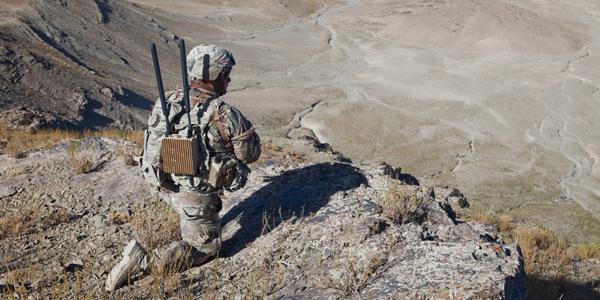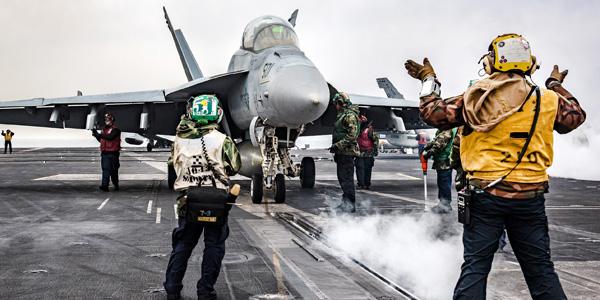Improving Electronic Warfare
As electronic warfare is re-emerging as a key battlefield function, the commercial sector is striving to offer advanced technologies. Land-based systems are needed to combat both ground and airborne adversarial threats, while airborne electronic warfare tools provide maneuverable tactics to marque aircraft.
The focus of Sierra Nevada Corporation’s (SNC’s) dismounted electronic countermeasure system, known as Modi, has evolved from defeating radio-controlled improvised explosive devices (RCIEDs) to being a multi-function electronic warfare (EW) tool, explained Jerry Coburn, director, business development, SNC, during a recent interview with SIGNAL Magazine.
The company, which field thousands of dismounted counter RCIED jammers to the Marines Corps, the Army, the U.S. Special Forces Command (SOCOM) and inter-agency partners in Iraq and Afghanistan, found that warfighters need a multi-function, multi-domain battlefield EW capability. Based on the demonstrations and joint exercises that SNC has participated in, warfighters are looking to defeat manned system threats in the air, small unmanned aerial systems (UASs) or adversaries’ command and control (C2) radios, as well as RCIEDs, Coburn said.
In order to succeed, a multi-function EW tool must have the ability to cover “the massive amount” of spectrum that threats operate in, Coburn noted. For instance, small UASs today operate “from down around 433 megahertz all the way up to 5 gigahertz and everywhere in between,” he said. Moreover, when confronted with a swarm of UASs of different sizes, “operating from low-band to Band B or Band C, an EW system must be able to look across all of that spectrum at once” and successfully offer a counter measure.
Coburn attested that the modularity and scalability of the Modi system makes it compatible with dismounted, manned portable devices or large vehicle platform-based power amplified systems. “They can swap them easily back and forth between configurations,” he said. “Everything from a large mine-resistant vehicle like an M-ATV [mine resistant ambush protected all-terrain vehicle], all the way down to the Polaris family of vehicles. And then if required, in a very austere environment where a vehicle platform either doesn’t make sense or is not available, that same system can be pulled out for a manned portable mode.”
In particular, SNC is venturing for its technology to be a replacement to the decade-old large platform-mounted EW systems in use by the Marines and Army—in order to provide the kind of spectrum and bandwidth coverage needed to defeat modern threats.
The further evolution of EW capabilities, including the move to integrate signals intelligence (SIGINT)/electronic intelligence (ELINT) and the communications domain is well within the company’s sights, Coburn claimed. “We are moving in that direction to integrate all of those domains into a single architecture,” he said. “We are hearing from the Air Force, Navy, Marines Corps and the Army that that type of total system architecture is a desired capability.” A system like that “strapped onto a device and hung on an aircraft either manned or unmanned,” also would provide a key faculty to warfighters.
Integration of that kind does mean coordination between the military’s program offices, which may be used to handle separate capabilities. For example, when the company sent out dismounted systems to be integrated on the Marines’ On The Move counter UAS platform with a radar electro-optical infrared (EOIR) system and SNC’s EW equipment, all of that was coordinated by that service’s air defense community, Coburn said.
“There certainly has been cross talking between the intel program office and the air defense program office about the system, which has been healthy because it took those two, which were once separate communities, and forced them into a dialogue that helped them understand how a single system can now essentially change function and address different threat categories through inputs from a software-based user interface,” he noted.
Turning to the advancement of airborne jammer capabilities, particularly for the U.S. Navy’s EA-18G aircraft, known as the Growler, the Naval Air Systems Command (NAVAIR) is in the process of reducing the transmitter weight of the AN/ALQ-99 low-band transmitter (LBT). NAVAIR’s effort is part of the low-band consolidation (LBC) Phase II follow on contract, which runs through July 2020 with Cobham Advanced Electronic Solutions Inc.
Meanwhile, the service is replacing the 40-year old AN/ALQ-99 technology with a more sophisticated Next Generation Jammer (NGJ) system that involves “a combination of high-powered, agile, beam-jamming techniques and cutting-edge solid-state electronics,” according to a description from the Association of Old Crows. A spokesman from the Naval Air Warfare Center Aircraft Division confirmed that the NGJ "will augment, then replace" the AN/ALQ-99 Tactical Jamming System on U.S. EA-18G aircraft. To combat modern threats, the NGJ system will include capabilities across low-, mid- and high-band frequencies.
In 2016, the Navy awarded a $1 billion sole source contract to the Raytheon Company to engineer and build the mid-band version (NGJ-MB) in an adaptable smart pod, following preliminary design work from a $279.4 million contract award to the company in July 2013. By December 2020, Raytheon must design, manufacture, integrate, demonstrate and test 15 NGJ-MB engineering development model pods for NAVAIR. The company also is producing 14 aeromechanical pods for mission systems testing and qualification, according to Raytheon. The aeromechanical pods “will be used to verify aircraft flying qualities and pod safe separation from the host aircraft; provide equipment needed for system integration laboratories; and mature manufacturing processes,” DOD stated.
An additional award this summer funded work for the airworthiness determination for the NGJ-MB. Under that effort through 2020, Raytheon will be conducting engineering analysis, instrumentation design and wind tunnel and commercial flight-testing to assess the aeromechanical pod’s prime power generation subsystem.
“NGJ-MB is a force multiplier and we are executing a plan to deliver this essential capability to the U.S. Navy,” said Travis Slocumb, vice president, Raytheon Electronic Warfare Systems, in a statement to SIGNAL.
In addition, the Navy is continuing its co-development work with the Australian government on the revamped communications countermeasures of the AN/ALQ-227. The AN/ALQ-227 operates on the Growler aircraft in conjunction with a receiver and the AN/ALQ-99 jamming pods. A $65 million award in June to Raytheon for system improvements, demonstration prototypes, pre-production products, support equipment enhancements, or simulations and models of weapons systems.
Meanwhile, Cobham, along with partner Lockheed Martin, are vying—among other companies—to provide the low-band (NGJ-LB) capability of the advanced jammer. A new system integrated on the EA-18G would provide “significantly greater” electronic attack capabilities in lower frequency bands than the AN/ALQ-99, according to Cobham.
NAVAIR released a broad agency announcement solicitation for the NGJ-LB—also referred to as Increment II of the NGJ—earlier this year. The resulting contract award from the NGJ-LB competition is still in the works, a NAVAIR spokesman confirmed.
With passage of the John S. McCain National Defense Authorization Act for Fiscal Year 2019 on August 1, Congress has approved continued funding for the Navy’s NGJ effort, authorizing the full $459.529 million DOD requested, as well as providing $109.479 million for Increment II. In addition, Congress authorized the $7.93 million DOD requested for construction of a NGJ facility at the Whidbey Island Naval Air Station near Oak Harbor, Washington.
The high-band capability of the NGJ, Increment III, will be developed in the future.






Comments